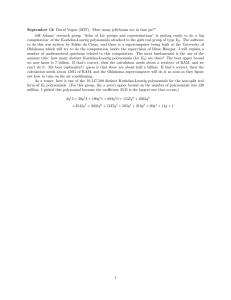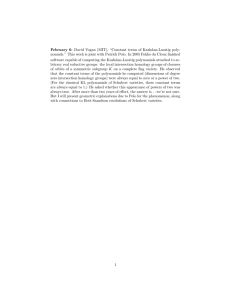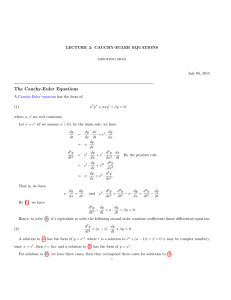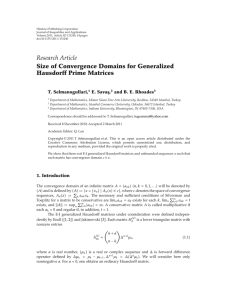Introduction to orthogonal polynomials Michael Anshelevich November 6, 2003
advertisement
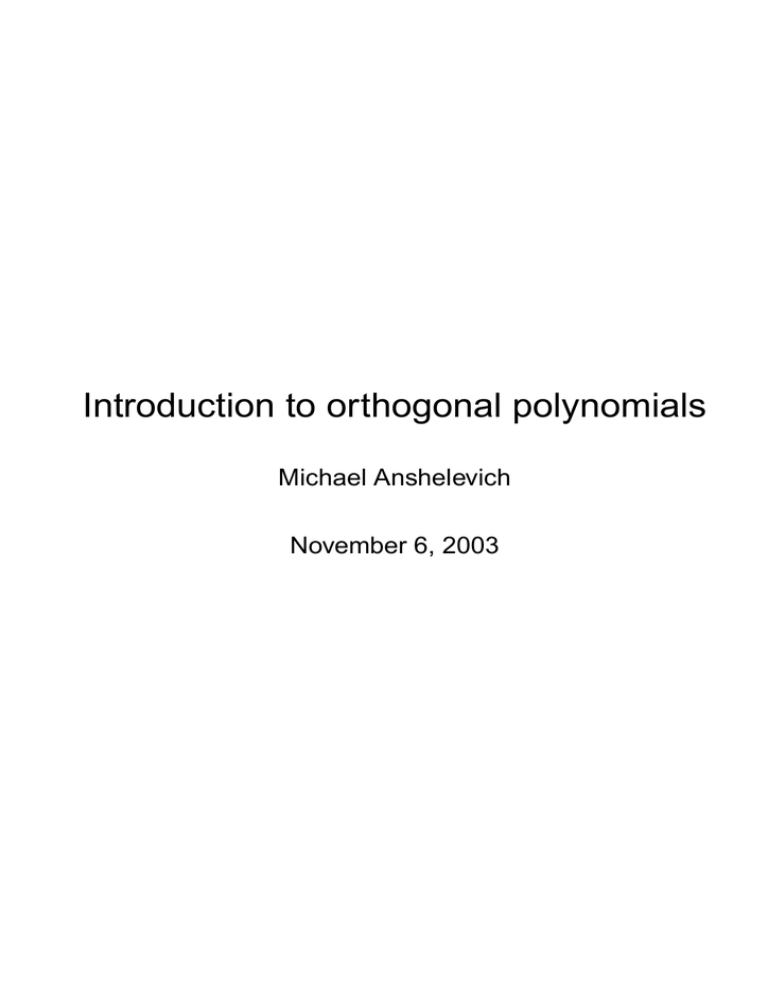
Introduction to orthogonal polynomials
Michael Anshelevich
November 6, 2003
µ = probability measure on R with finite moments
Z
mn(µ) =
R
xn dµ(x) < ∞.
Induces a functional on polynomials C[x],
Z
ϕ [P (x)] =
R
P (x) dµ(x).
On the polynomials C[x], define the sesquilinear inner
product
D
xn, xk
E
µ
= ϕµ
h
xn+k
i
= mn+k (µ).
The set {xn}∞
n=0 is a basis for C[x]. Gram-Schmidt with
respect to the inner product h·, ·iµ, get a family of polynomials
{Pn}∞
n=0 .
Note they have real coefficients. They are orthogonal
with respect to µ:
Z
ϕµ [PnPk ] =
R
Pn(x)Pk (x) dµ(x) = 0
if n 6= k.
1
Hermite polynomials: normal (Gaussian) distribution
2 /2t
1
−x
√
e
dx.
2πt
0.4
0.3
0.2
0.1
–4
–2
0
2
4
x
Laguerre polynomials: Gamma distribution
1 −x t−1
e x
1[0,∞)(x) dx.
Γ(t)
1
0.8
0.35
0.3
0.25
0.6
0.2
0.15
0.4
0.1
0.2
0.05
0
1
3
2
4
0
5
1
3
2
x
x
Jacobi polynomials:
1
(1 − x)α(1 + x)β 1[−1,1](x) dx.
Z(α, β)
In particular: Ultraspherical (Gegenbauer),
α=β =λ−1
2,
1
1
λ− 2
2
(1 − x )
1[−1,1](x) dx,
Z(λ)
2
4
5
Chebyshev of the 1st kind, α = β = − 1
2 , λ = 0,
1
1
q
1[−1,1](x) dx,
π 1 − x2
6
5
4
3
2
1
–1
–0.8
–0.6
0
–0.2
–0.4
0.2
0.6
0.4
0.8
1
x
Chebyshev of the 2nd kind, α = β = 1
2 , λ = 1,
2
π
q
1 − x2 1[−1,1](x) dx,
0.6
0.5
0.4
0.3
0.2
0.1
–1
–0.8
–0.6
–0.4
–0.2
0
0.2
0.6
0.4
0.8
1
x
Kravchuk: binomial distribution, for q = 1 − p,
N ³ ´
X
N k N −k
p q
δ2k−N (x).
k
k=0
0.3
0.25
0.2
0.15
0.1
0.05
–4
–2
0
2
4
k
3
Charlier: Poisson distribution
∞
X
k=0
e−t
tk
δk (x).
k!
0.25
0.2
0.15
0.1
0.05
0
3
2
1
5
4
k
Meixner: negative binomial (Pascal) distribution
X ³k − 1 ´
pt q k−t δk (x).
t−1
k≥t
0.26
0.24
0.22
0.2
0.18
0.16
0.14
0.12
0.1
0
1
2
3
4
5
6
7
8
k
Can describe in various ways:
• Using the measure of orthogonality.
• 2nd order differential or difference equations.
• Explicit formulas using hypergeometric functions.
• Three-term recursion relations.
4
Favard’s theorem. (Stone 1932) Let {Pn}∞
n=0 be a polynomial family, that is, Pn has degree n.
{Pn} are orthogonal with respect to some measure µ
with positive leading coefficients ⇐⇒ they satisfy a threeterm recursion relation
P0(x) = 1,
xP0(x) = α0P1(x) + β0P0(x),
xPn(x) = αnPn+1(x) + βnPn(x) + γnPn−1(x),
where all βn are real, αn > 0, γn ≥ 0.
Moreover, {Pn} are monic iff all αn = 1.
{Pn} are orthonormal iff γn = αn−1.
µ has finite support iff γn = 0 for some n.
5
⇒) Suppose the polynomials are orthogonal with respect
to µ and have positive leading coefficients. Then
¡
¢
Pn ⊥ span P0, P1, . . . , Pn−1 .
So
hxPn, Pk iµ = 0
for n + 1 < k, and also
hxPn, Pk iµ = ϕµ [xPnPk ] = hPn, xPk i = 0
for n > k + 1, n − 1 > k. So
xPn(x) = αnPn+1(x) + βnPn(x) + γnPn−1(x)
for some real αn, βn, γn.
Leading coefficients of Pn, Pn+1 are positive ⇒ αn > 0.
Also, (leading coefficients are 1) ⇔ αn = 1.
6
From the recursion relation,
hxPn, Pn−1i = γn hPn−1, Pn−1i .
Also, from the recursion
xPn−1(x)
= αn−1Pn(x) + βn−1Pn−1(x) + γn−1Pn−2(x),
it follows that
hxPn, Pn−1i = hPn, xPn−1i = αn−1 hPn, Pni .
So
γn hPn−1, Pn−1i = αn−1 hPn, Pni .
So γn ≥ 0, and {Pn} are orthonormal iff γn = αn−1.
Finally, γn = 0 ⇔ hPn, Pni = 0.
7
⇐) Suppose the polynomials satisfy a three-term recursion relation
xPn(x) = γn+1Pn+1(x) + βnPn(x) + γnPn−1(x).
On C[x], define a functional ϕ by
ϕ [PnPk ] = δnk
and extend linearly: for
A(x) =
X
n
anPn(x),
B(x) =
X
bk Pk (x),
k
ϕ [AB ] =
XX
n
anb̄k ϕ [PnPk ] =
k
X
n
anb̄n.
Why consistent? Suppose
A1B1 = A2B2,
to show
ϕ [A1B1] = ϕ [A2B2] .
8
Factoring over C, enough to show
ϕ [(A(x)(x − a))B(x)] = ϕ [A(x)((x − a)B(x))]
for a ∈ C. By linearity, enough to show
ϕ [(Pk (x)x)Pn(x)] = ϕ [Pk (x)(xPn(x))] .
But from the recursion relation, these are
γk+1δk+1,n + βk δk,n + γk δk−1,n
= γn+1δk,n+1 + βnδk,n + γnδk,n−1.
9
Remains to show ϕ = ϕµ for some measure µ. Note: µ
not unique.
* n
X
i=0
aiPi(x),
n
X
i=0
+
n
X
=
aiPi(x)
ϕ
|ai|2 > 0
i=0
so the induced inner product is positive definite (assume
non-degenerate) Let H be the Hilbert space completion
of C[x] with respect to the inner product h·, ·iϕ, and X be
the operator with dense domain C[x] defined by
XA(x) = xA(x).
Then X is an unbounded symmetric operator. Has a selfadjoint extension? von Neumann: look at the deficiency
subspaces
K± = ker(X ∗ ∓ i).
A self-adjoint extension exists iff the deficiency indices
d± = dim(K±) are equal.
10
Let
C
µX
n
aj xj
¶
=
j=0
n
X
āj xj .
j=0
Since
hC(P ), C(P )iϕ = hP, P iϕ = hP, P iϕ ,
C can extend to an operator on H. It commutes with X,
so
C(K±) = K∓.
Indeed,
K+ = {η ∈ H : X ∗η = iη}
= {η ∈ H : ∀P ∈ R[x], hη, XP i = hiη, P i} .
But
hC(η), X(P )i = hη, CX(P )i = hη, XC(P )i
= hiη, C(P )i = h−iη, P i .
We conclude that
d+ = d−.
11
Let X̃ be a self-adjoint extension of X. It has a spectral
measure: for any subset S ⊂ R, have a projection E(S).
Define
µ(S) = h1, E(S)1i .
This is a probability measure. In fact,
Z
mn(µ) =
DR
¿
xn dµ(x) = 1,
E
Z
R
xn dE(x) 1
À
= 1, X̃ n1 = h1, xni = ϕ [xn] .
X̃ not unique ⇒ µ not unique.
12
Hermite:
xPn = Pn+1 + tnPn−1.
Laguerre:
xLn = Ln+1 + (t + 2n)Ln + n(t + n − 1)Ln−1.
Jacobi:
β 2 − α2
Pn
xPn = Pn+1 +
(2n + α + β)(2n + α + β + 2)
4n(n + α)(n + β)(n + α + β)
+
Pn−1 .
(2n + α + β − 1)(2n + α + β)2 (2n + α + β + 1)
Ultraspherical:
xPn = Pn+1 +
n(n + 2λ − 1)
Pn−1.
4(n + λ − 1)(n + λ)
Chebyshev:
1
xPn = Pn+1 + Pn−1.
4
13
Kravchuk:
for a = (1 − 2p), b = 4pq, a2 − b = 1,
xKn = Kn+1 + a(2n − N )Kn + bn(N − n + 1)Kn−1.
Charlier:
xPn = Pn+1 + (t + n)Pn + tnPn−1.
Meixner:
1 , b = qp−2 , a2 − b = 1 > 0,
for a = p−1 − 2
4
xMn = Mn+1 + a(t + 2n)Mn + bn(t + n − 1)Mn−1.
Meixner-Pollaczek: same for a2 − b < 0. Note for Laguerre, a2 − b = 0.
14
Can study zeros, asymptotics, continued fractions. Instead:
Denote {en} the basis of H coming from {Pn}
Xen = γn+1en+1 + βnen + γnen−1.
X has a tri-diagonal matrix
β γ1
0
γ1 β1 γ2
γ2 β2
γ3
γ3
...
...
.
. . .
Thus X is a sum of three operators: creation
A∗en = γn+1en+1,
annihilation
Aen = γnen−1,
and preservation
N en = βnen.
15
Since βn is real, N is symmetric, and
hA∗e
n , ek i
D
E
= γn+1 en+1, ek = γn+1δn+1,k
­
®
= γk en, ek−1 = hen, Aen−1i .
A, A∗ are (formal) adjoints of each other.
For the Hermite polynomials, N = 0, A, A∗ are the usual
annihilation and creation operators.
For the Charlier polynomials, A, A∗ are as before, and N
is (almost) the number operator.
16
Another way to look at this. Heisenberg Lie algebra Ht
has the basis {A, A∗, t} subject to the relation
[A, A∗] = t,
t scalar.
Each Ht has a representation on some Hilbert space H
with basis {en}∞
n=0 :
√
A en = tn en−1,
A∗en =
q
t(n + 1) en+1.
(AA∗ − A∗A)en = [t(n + 1) − tn]en = ten.
17
If we want
A + A∗ = X,
where
XP (x) = xP (x),
can take
H = L2(R, µt)
for
µt = Gaussian measure,
and
en = Pn(x, t) = Hermite polynomials.
In this representation,
A = t∂x,
A∗ = x − t∂x.
18
Oscillator Lie algebra Ost has the basis {A, A∗, N, t}
subject to the relations
[A, A∗] = t,
[A, N ] = A,
[N, A∗] = A∗,
t scalar.
Each Ost has a representation on some H:
√
A en = tn en−1,
q
A∗en = t(n + 1) en+1,
N en = (t + n)en.
Note e0 is a cyclic vector. In fact, the representation is
irreducible. If we want
A + A∗ + N = X,
can take H = L2(R, µt) for
µt = Poisson measure,
and
en = Pn(x, t) = Charlier polynomials.
A = t∆, ∆(P ) = P (x) − P (x − 1),
A∗(P ) = xP (x − 1) − tP, N (P ) = x∆P + tP (x − 1).
19
The Lie algebra
n sl(2, R) of
o real traceless 2 × 2 matrices
has the basis J−, J+, J0
Ã
J− =
!
Ã
0 0
,
−1 0
J+ =
!
0 1
,
0 0
Ã
J0 =
!
1 0
,
0 −1
subject to the relations
[J−, J+] = J0,
[J−, J0] = 2J−,
[J0, J+] = 2J+.
Abstract representations, parameterized by t > 0:
q
J− en =
J+ en =
q
n(t + n − 1) en−1,
(n + 1)(t + n) en+1,
J0 en = (t + 2n)en.
Want
J− + J+ + cJ0 = X.
20
For each t, c, sl(2, R) has a representation on L2(R, µt,c),
for
negative binomial (Meixner),
µt,c =
Gamma (Laguerre),
. . . (Meixner-Pollaczek),
c > 1,
c = 1,
0 < c < 1.
Where are the finite-dimensional representations?
Take t = −N , N > 0 integer.
q
J− en = − n(N − n + 1) en−1,
q
J+ en = (n + 1)(N − n) en+1,
J0 en = (2n − N )en.
Finite-dimensional since J+eN = 0. Can take
µN = binomial measure,
en = Pn(t, N ) = Kravchuk polynomials.
21
For example, for N = 1,
dµ(x) = qδ−1(x) + pδ1(x)
is the Bernoulli distribution,
K0 = 1,
K1 = x + (1 − 2p).
In the basis (K1, K0) for
L2(R, µ) = C2,
J−, J+, J0 have matrices as above, and
Ã
X = J+ − 4pqJ− + (q − p)J0 =
q−p
1
4pq p − q
!
sends
³
´
X : (K0 = 1) 7→ K1 − (1 − 2p)K0 = x
and
X : K1 7→ (q − p)K1 + 4pqK0
= (q − p)x + (1 − 2p)2 + 4p(1 − p)
= (q − p)x + 1.
22
Note that for x = −1,
xK1(x) = 2p = (q − p)x + 1,
and for x = 1,
xK1(x) = 2q = (q − p)x + 1,
so
xK1(x) = (q − p)x + 1
and
J+ − 4pqJ− + (q − p)J0 = multiplication by x.
23
Additional material:
1) The Hilbert space H (the closure of C[x] with respect to h·, ·iµ )
is not always equal to L2 (R, µ). In fact, C[x] is dense in L2 (R, µ)
if and only if µ comes from a self-adjoint extension of a symmetric
operator as in slide 12; there may be measures that do not.
2) For the uses of representation theory to obtain results about orthogonal polynomials, see reference 4.
3) Different representations of the Lie algebra sl(2, R) on slide 21,
distinguished by the parameter c, correspond to representations of
different Lie groups all of which have the same Lie algebra. See
reference 3.
R EFERENCES
1. N. I. Akhiezer, The classical moment problem and some related
questions in analysis, Hafner Publishing Co., New York, 1965.
2. Barry Simon, The classical moment problem as a self-adjoint finite
difference operator, Adv. Math. 137 (1998), no. 1, 82–203.
3. Philip Feinsilver and René Schott, Algebraic structures and operator calculus. Vol. I, Kluwer Academic Publishers Group, Dordrecht,
1993, Representations and probability theory.
4. H. T. Koelink and J. Van Der Jeugt, Convolutions for orthogonal
polynomials from Lie and quantum algebra representations, SIAM J.
Math. Anal. 29 (1998), no. 3, 794–822 (electronic).
5. Erik Koelink, Spectral theory and special functions, Lecture notes
for the SIAM Activity Group OP-SF summer school 2000, Laredo,
Spain. arXiv:math.CA/0107036.
24



